
QE’s pupil-run arts magazine, The Arabella, looks both to the past and the future in a special edition for the School’s 450th anniversary year.
 The 44-page publication features 26 pieces of poetry, prose, and art, many of them inspired by its anniversary-related theme, How did we get here? The approach, looking both backward and forward, mirrors that of the School’s anniversary celebrations on Founder’s Day which included a display of the School’s 1573 Royal Charter alongside the burying of a time capsule intended for the pupils of 2073, when QE will mark its 500th anniversary. Work on the magazine began last academic year, but it has only now been published.
The 44-page publication features 26 pieces of poetry, prose, and art, many of them inspired by its anniversary-related theme, How did we get here? The approach, looking both backward and forward, mirrors that of the School’s anniversary celebrations on Founder’s Day which included a display of the School’s 1573 Royal Charter alongside the burying of a time capsule intended for the pupils of 2073, when QE will mark its 500th anniversary. Work on the magazine began last academic year, but it has only now been published.
Assistant Head (Pupil Involvement) Crispin Bonham-Carter said: “The ninth edition of The Arabella has been worth the wait: with its expanded contents and an eclectic mix of topics and styles, it is a great demonstration of the fruits of free-thinking scholarship and academic curiosity.”
The magazine includes contributions from boys throughout the School, although boys from the current Years 8 and 9 feature especially heavily.
In his introduction, one of the editors, Chanakya Seetharam, of Year 12, addresses his fellow QE pupils: “Just as the [450th anniversary thanksgiving] service at Westminster Abbey in the Spring Term so well captured, this is as much cause to look back with an inquisitive eye into the past as to look forward to the future. It is this spirit of investigation that is the kernel of this edition, and which was so well taken up by you….
“You are what keeps The Arabella alive. This is a magazine by you and for you. We hope you will find all of the work here thoroughly insightful, interesting, and enjoyable, and here’s to a great next edition!”
 The poetry section is highly varied, with contributions ranging from Year 9 boy Yingqiao Zhao’s piece about the moon – which is in the shape of a crescent and has key words picked out in different colours – to the nine-stanza rhyming French poem, La Mort de L’Ancien, composed by Year 13’s Aayush Backory. The poetry section closes with Nikhil Francine, of Year 9, addressing the anniversary directly with a poem entitled Thriving from Ancient Roots – the School’s slogan for the anniversary year.
The poetry section is highly varied, with contributions ranging from Year 9 boy Yingqiao Zhao’s piece about the moon – which is in the shape of a crescent and has key words picked out in different colours – to the nine-stanza rhyming French poem, La Mort de L’Ancien, composed by Year 13’s Aayush Backory. The poetry section closes with Nikhil Francine, of Year 9, addressing the anniversary directly with a poem entitled Thriving from Ancient Roots – the School’s slogan for the anniversary year.
The creative writing pages included Year 9 pupil Raaghav Dhanasekaran predicting a dystopian future amid huge hurricanes caused by climate change.
The music writing section on the other hand looks mostly to the past, from Nikhil Francine’s essay on A brief history of song to Moneshan Rathaparan and Eshwara Masina, both of Year 8, jointly exploring The Enduring Influence of Classical and Baroque Music on Contemporary Culture.
Year 12 student Akheel Kale, from the editorial team, praises the quality of Year 13 pupil Ashish Yeruva’s essay on Justice for Ukraine: How to Put Russian Leaders on Trial Using International Law. Ashish’s contribution had inspired the team to open a current affairs section in the magazine and to invite further such submissions in the future, Akheel says.
Similarly, the magazine has a new section on Science, featuring Year 10 boy Zain Syed’s submission of an extensive flow chart setting out A Natural History of the Earth.
 Interspersed throughout The Arabella are artworks exploring themes including Expressive Heads, Distortion and Identity; Dystopian Landscape; and Art Inspired by Music. Shown in this news story, from top to bottom, are:
Interspersed throughout The Arabella are artworks exploring themes including Expressive Heads, Distortion and Identity; Dystopian Landscape; and Art Inspired by Music. Shown in this news story, from top to bottom, are:
- Expressive Heads, Distortion and Identity, by Sushan Naresh, Year 10 (main image)
- Dystopian Landscape, by Krishav Sundar Rajan, Year 9
- Art Inspired by Music, by Galinghan Balamurugan, Year 8
- Expressive Heads, Distortion and Identity, by Ayush Saha, Year 10
The magazine is named after Arabella Stuart, a descendant of Henry VII and sixth in line to the throne, who fell foul of King James I when in 1610 she secretly married another potential heir to the throne, William Seymore. Her husband was sent to the Tower of London, while Arabella was committed to the care of the Bishop of Durham, but fell ill in Barnet en route. She stayed for some months at the home of QE Governor Thomas Conyers, her spiritual needs attended to by another Governor, Rev Matthias Milward, who was subsequently appointed Master (Headmaster) of the School.
- For anyone with access to the School’s eQE portal, The Arabella is available to read here.
